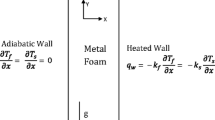Abstract
For modeling solidification process of casting accurately, a reliable heat transfer boundary condition data is required. In this paper, an inverse conduction model was established to determine the heat flux and heat transfer coefficient at the metal–sand mold interface for cylindrical casting in the lost foam process. The numerically calculated temperature was compared with analytic solution and simulation solution obtained by commercial software ProCAST to investigate the accuracy of heat conduction model. The instantaneous cast and sand mold temperatures were measured experimentally and these values were used to determine the interfacial heat transfer coefficient (IHTC). The IHTC values during lost foam casting were shown to vary from 20 to 800 W m−2 K−1. Additionally, the characteristics of the time-varying IHTC have also been discussed in this study.







Similar content being viewed by others
References
Seo KK, Kwon HK (2013) Simulation study and application on HPDC process with automobile. Adv Mater Res 658:281–286
Jaluria Y (2013) Challenges in the accurate numerical simulation of practical thermal processes and systems. Int J Numer Method H 23:158–175
Gu KZ, Wang WL, Zhou LJ, Ma FJ, Huang DY (2012) The effect of basicity on the radiative heat transfer and interfacial thermal resistance in continuous casting. Metall Mater Trans B 43:937–945
Hasan HS, Peet MJ (2012) Heat transfer coefficient and latent heat of martensite in a medium-carbon steel. Int Commun Heat Mass 39:1519–1521
Nowak I, Smolka J, Nowak AJ (2010) An effective 3-D inverse procedure to retrieve cooling conditions in an aluminium alloy continuous casting problem. Appl Therm Eng 30:1140–1151
Nallathambi AK, Specht E (2009) Estimation of heat flux in array of jets quenching using experimental and inverse finite element method. J Mater Process Tech 209:5325–5332
Rajaraman R, Velraj R (2008) Comparison of interfacial heat transfer coefficient estimated by two different techniques during solidification of cylindrical aluminum alloy casting. Heat Mass Transfer 44:1025–1034
Nallathambi AK, Specht E (2009) Estimation of heat flux in array of jets quenching using experimental and inverse finite element method. J Mater Process Tech 209:325–332
Ilkhchy AF, Jabbari M, Davami P (2012) Effect of pressure on heat transfer coefficient at the metal/mold interface of A356 aluminum alloy. Int Commun Heat Mass 39:705–712
Kovačević L, Terek P, Kalaš D, Miletić A (2012) A correlation to describe interfacial heat transfer coefficient during solidification of Al–Si alloy casting. J Mater Process Tech 212:1856–1861
Silva JN, Moutinho DJ, Moreira AL (2011) Determination of heat transfer coefficients at metal–mold interface during horizontal unsteady-state directional solidification of Sn–Pb alloys. Mater Chem Phys 130:179–185
Arunkumar S, Rao KVS, Kumar TSP (2008) Spatial variation of heat flux at the metal mold interface due to mold filling effects in gravity die-casting. Int J Heat Mass Transfer 51:676–685
Long A, Thornhill D, Armstrong C (2011) Determination of the heat transfer coefficient at the metal–die interface for high pressure die cast AlSi9Cu3Fe. Appl Therm Eng 31:3996–4006
Lewis RW, Nithiarasu P, Seetharamu KN (2004) Fundamentals of the finite element method for heat and fluid flow. Wiley, England
Zhang LQ, Reily C, Li LX, Cockcroft S, Yao L (2014) Development of an inverse model and its application to determine the heat transfer coefficient during casting solidification. Heat Mass Transfer 50:945–955
Spinelli JE, Cheung N, Goulart PR (2012) Design of mechanical properties of Al-alloys chill castings based on the metal/mold interfacial heat transfer coefficient. Int J Therm Sci 51:145–154
Peng ZP, Xiong SM, Liu BC, Li M, Allison J (2008) Effect of process parameters, casting thickness, and alloys on the interfacial heat-transfer coefficient in the high-pressure die-casting process. Metall Mater Trans A 39:2896–2905
Coates B, Argyropoulos SA (2007) The effects of surface roughness and metal temperature on the heat-transfer coefficient at the metal mold interface. Metall Mater Trans A 38:243–255
Acknowledgments
The research supports from Scientific Research Fund of Hunan Provincial Education Department (No. 13B145), Science and Technology Innovative Research Team in Higher Educational Institutions of Hunan Province and Open Research Fund Program of the State Key Laboratory of Advanced Design and Manufacturing for Vehicle Body (No. 31415003) are gratefully acknowledged.
Author information
Authors and Affiliations
Corresponding author
Rights and permissions
About this article
Cite this article
Zhang, L., Tan, W. & Hu, H. Determination of the heat transfer coefficient at the metal–sand mold interface of lost foam casting process. Heat Mass Transfer 52, 1131–1138 (2016). https://doi.org/10.1007/s00231-015-1632-1
Received:
Accepted:
Published:
Issue Date:
DOI: https://doi.org/10.1007/s00231-015-1632-1




